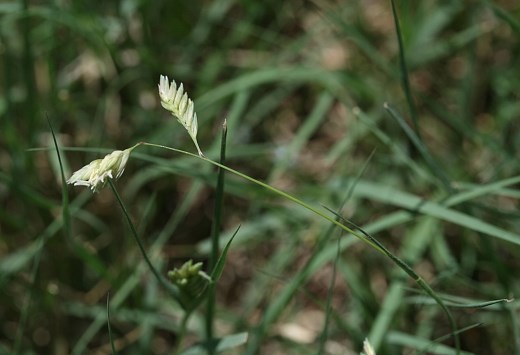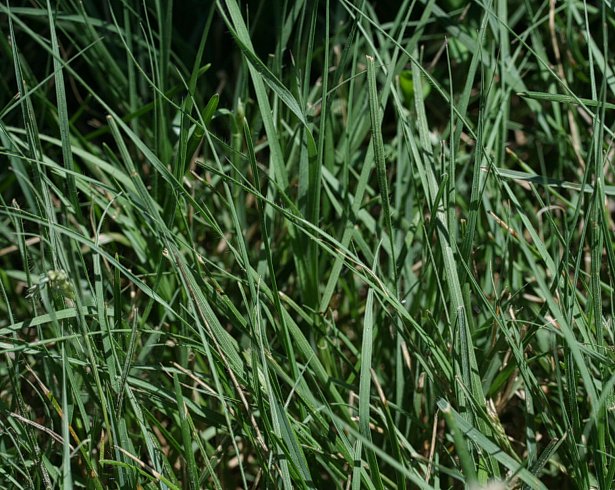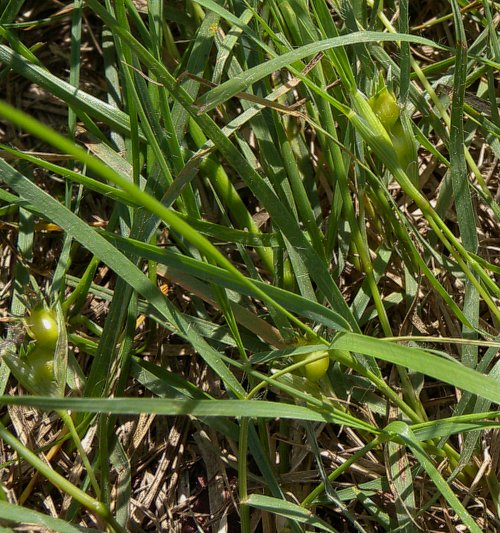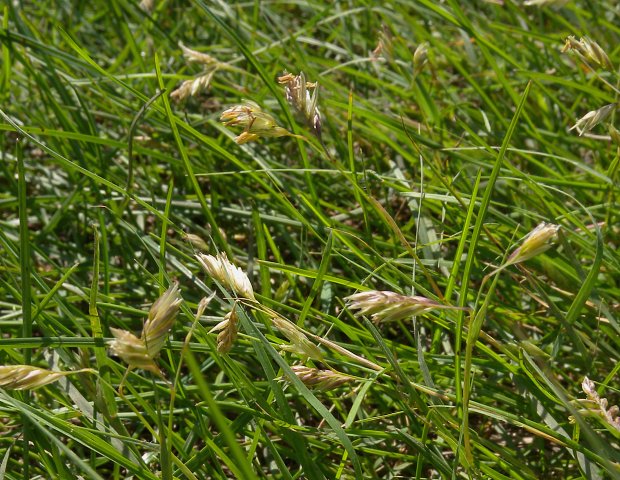Description: This dioecious perennial grass has separate male (staminate) and female (pistillate) plants. There are also vegetative shoots without spikelets. The male plants are about 6-8" tall; they have unbranched culms with about 3-4 alternate leaves along the lower two-thirds of the culm. The culms are light green, glabrous, terete to somewhat flattened in cross-section, and mostly hidden by the sheaths. The leaf blades are up to 4" (10 cm.) long and 2.5 mm. across; they are grayish green, grayish blue, or dull green. In addition, these blades are sparsely hairy or minutely pubescent on both sides (upper & lower), and they are ascending to widely spreading. The open leaf sheaths are light grayish green or light green, longitudinally veined, and mostly hairless, except toward the apex. The nodes are swollen, light green, and glabrous; the culm is often purplish immediately above and below each node. At the junction of each sheath and blade, the ligule consists of a short tuft of curly white hairs. The vegetative characteristics of the female plants are similar to the male plants, except that their culms are much shorter.

The culm of each male plant terminates in an inflorescence consisting of 2-3 staminate spikes. The typical staminate spike is about 8-15 mm. (1/3–2/3") in length and about 4 mm. across. Each of these spikes has about 6-12 spikelets that are arranged in 2 rows on one side of the floral stalk (the spike's rachis). Each staminate spikelet has a pair of glumes at its base and 2-3 lemmas that are arranged side-by-side. One glume is about 3.0 mm. in length, while the remaining glume and lemmas are about 4.0–4.5 mm. in length. The glumes and lemmas are linear-lanceolate in shape and hairless. They are initially light green, but become light tan and chaffy at maturity. Disarticulation of the spikelets is above the glumes. The short culm of each female plant terminates in a cluster of 2-3 pistillate spikelets that are joined together at the base. These spikelets are largely hidden by the leaf blades. The outer sides of each pistillate spikelet consist of a glume and a lemma that are joined together at the edges, forming an ovoid structure that contains the pistillate floret. The glume and lemma are similar in size and shape; they become swollen and rounded toward the middle and each one has 3 cleft lobes with pointed tips at its apex. The blooming period usually occurs during early to mid-summer. Each pistillate spikelet of a female plant produces a single large seed. The root system is fibrous and stoloniferous. In open areas, this grass readily spreads by its stolons to form a soft turf.

Cultivation:
The
preference is full sun, dry conditions, and barren soil. This species
doesn't tolerate competition from taller plants. It can adapt to a less
ideal site with partial sun, mesic conditions, or fertile soil if there
is a regimen of regular mowing (as occurs in lawns). Most vegetative
growth occurs during the summer. Because of its C4 metabolism and other
characteristics, this grass has exceptional drought resistance.
Range & Habitat:
Buffalo Grass is a rare plant in the natural areas of Illinois (see
Distribution
Map).
Some populations are thought to be native
(particularly in central & NW Illinois), while other
populations have been introduced. These introduced plants are either
adventive from the Western states, or they have escaped from local
lawns where Buffalo Grass has been used as a turf grass. Habitats
include hill prairies, cemetery prairies, lawns, and barren waste
areas. In dry areas, this grass helps to bind the soil and prevent
erosion by wind or water. It is one of the dominant grasses of the
shortgrass prairie in the Great Plains.

Faunal Associations: Several species of grasshoppers feed on the foliage of Buffalo Grass (see Grasshopper Table); they include Ageneotettix deorum (White-whiskered Grasshopper), Arphia pseudonietana (Red-winged Grasshopper), Dissosteira carolina (Carolina Grasshopper), Orphulella speciosa (Slant-faced Pasture Grasshopper), Phoetaliotes nebrascensis (Large-headed Grasshopper), and Spharagemon collare (Mottled Sand Grasshopper). These observations have occurred primarily in other states where Buffalo Grass is more abundant. Another insect that feeds on this grass is Blissus occiduus (Buffalo Grass Chinch Bug), as does the monophagous Aceria slykhuisi (Buffalo Grass Mite). In the shortgrass prairie of the Great Plains, this grass is eaten by Buffalo and Pronghorn. It is also eaten by other hoofed mammalian herbivores, including deer, horses, cattle, and other livestock.

Photographic
Location:
Mowed lawns in or near Urbana, Illinois.
Comments:
During the summer, this grass forms an attractive soft turf
that is grayish green, bluish green, or green. However, it dies down
during the winter.
Buffalo Grass resembles the shorter Bouteloua spp.
(Grama grasses), including Bouteloua gracilis (Blue
Grama) and Bouteloua hirsuta (Hairy Grama). These
short grasses produce floral spikes that are shaped like small combs or
eyelashes. Unlike these Grama grasses, Buffalo Grass is
dioecious, producing separate staminate (male) and pistillate
(female) spikes on different plants. The short length of pistillate
culms for Buffalo Grass is probably an adaptation to grazing by hoofed
mammalian herbivores, as its large grains are less likely to be
consumed and crushed by their chewing mouth parts.